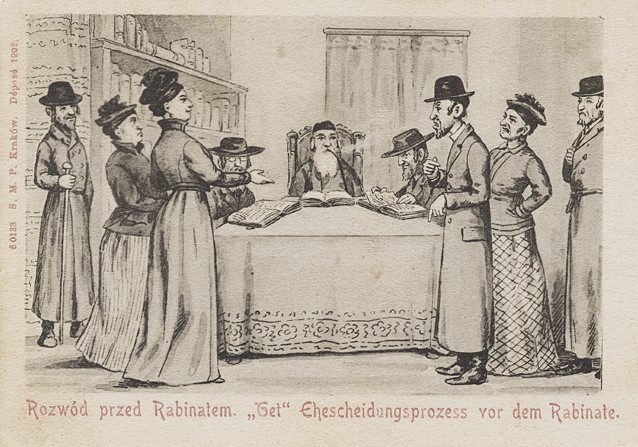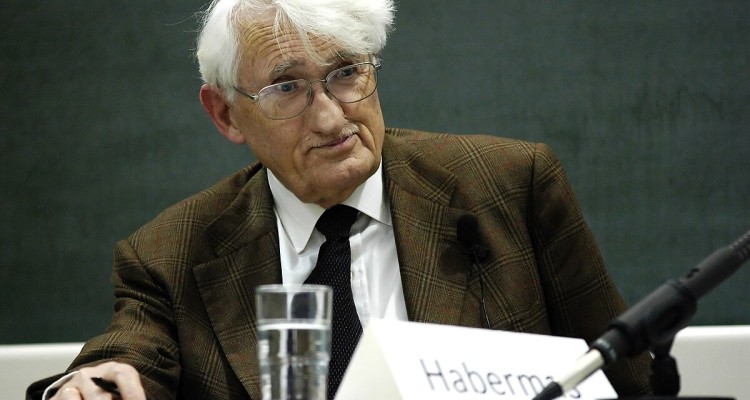The get, the centrepiece of traditional divorce, is a particularly sensitive legal act which today seems to be the focus of the greatest tension between civil law and Jewish law. Is it a place of confrontation? Astrid von Busekist sees it more as a place where a legal pluralism is formed, capable of honouring freedom of religious practice while bending it towards recognition of the general principle of equality for all.

Eighty-nine percent of self-identified secular Israelis are in favor of changing the law on marriage and divorce; only nineteen percent of self-identified secularists would choose to marry according to the Orthodox rite if they had the choice; sixty-eight percent of Israelis are in favor of a law that would liberalize marriage. Yet, the rabbinate and the vast majority of the Orthodox are not prepared to accept the loss of their monopoly. In Israel, civil marriage exists de facto—a couple can marry abroad and then register their union in Israel since 1963, and can even marry by Zoom[1]—, and civil unions are legal. However, this liberality on the part of the state does not solve the problem of the end of the marriage, the “get,” i.e., the bill of divorce that is exchanged, but only offers an alternative to those who do not want to submit to the rabbinical circuit[2].
The law is the law
Eighty-nine percent of self-identified secular Israelis are in favor of changing the law on marriage and divorce; only nineteen percent of self-identified secularists would choose to marry according to the Orthodox rite if they had the choice; sixty-eight percent of Israelis are in favor of a law that would liberalize marriage. Yet, the rabbinate and the vast majority of the Orthodox are not prepared to accept the loss of their monopoly. In Israel, civil marriage exists de facto—a couple can marry abroad and then register their union in Israel since 1963, and can even marry by Zoom—, and civil unions are legal. However, this liberality on the part of the state does not solve the problem of the end of the marriage, the “get,” i.e., the bill of divorce that is exchanged, but only offers an alternative to those who do not want to submit to the rabbinical circuit.
It is 2014 in Israel, and she’s been waiting 14 years for her release. After discovering her husband’s homosexual relationship, she immediately files for divorce with a rabbinical court in Jerusalem. The court takes six years to consider the petition, finally decides that it is justified, and orders the husband to give her the get. The husband refuses to comply. The wife is shackled for another six years—that’s how long it takes for the rabbinical court to sentence the husband to imprisonment. In the meantime, the wife has filed suit in civil court for financial damages and emotional distress. From his cell, the husband still refuses to release her. The stakes are rising—he is now demanding that the civil suit be withdrawn or he will not give the get. The president of the Great Rabbinical Court is not insensitive to this blackmail and, eager to resolve the matter once and for all, threatens to order the man’s release if the civil suit is not withdrawn.
The wife, supported by Mavoi Satum, an association for the defense of the agunot[3], then takes her case to the Supreme Court.[4] The latter considers that a rabbinical court does not have the authority to demand the withdrawal of a complaint. It orders the husband to remain in prison. The Great Rabbinical Court then suggests that the wife give up her share of the apartment (estimated value: 300,000 shekels). It turns out that the husband already owes her about 1.5 million shekels in alimony. [In a landmark decision in 1994, the Supreme Court, under the presidency of Aharon Barak, established the rule of equality in the distribution of property. Whereas the rabbinical court had decided to deprive a woman of half the marital assets on the pretext that Jewish law does not recognize the “presumption of cooperation,” the Court ruled that a woman cannot be dispossessed when a marriage is dissolved.] Contravening the Supreme Court’s decision, the Great Rabbinical Court has the husband released. Back to Jerusalem. Following pressure from Mavoi Satum, the woman is heard again a few months later. This time, Chief Rabbi Lau, as one of the dayanim [judges], succeeds in convincing the husband to give up his blackmail and grant his wife the get.
The moral of the story? Chief Rabbi Lau opposed the purchase of a get that is rightfully due, the haggling that goes on “in the shadow of the law,[5]” and, according to the wife’s lawyer, “reasoned in terms of fundamental democratic values, including women’s rights.[6]”
Here we go. Get stories are primarily women’s stories. There are certainly cases where they are the ones who are incriminated, the ones who negotiate advantages, the ones who prevent their husbands from divorcing, but they are rare. In any case, the punishment is not comparable, as we know. Without a prior get, unlike a man’s remarriage, any new union is adulterous for the woman and akin to a capital crime; the children born of the new union are considered illegitimate, and they too are adulterous [mamzerim], unlike the children born of a man’s new union. These children cannot marry a Jew; they can only marry their own kind. And the stigma lives on—they remain mamzerim beyond the “tenth generation” (Deuteronomy 23:2)[7].
In the talmudic tradition, however, divorce itself is not stigmatized; the ketubah is a document that contains all sorts of pragmatic provisions and agreements between spouses[8], including clauses for the eventual dissolution of the marriage. In Kiddushin (2 a-b), we learn how to “acquire” a wife, and in Ketubot (63b, 77a) the good reasons for requesting a divorce (boils or sexual incompatibility, apostasy). Although the husband’s power of repudiation is almost absolute (Yevamot, 112b, Gittin 90a-b), and the rules governing the get are very strict, their prosaic nature shows that they are contractual arrangements. It was also for pragmatic reasons that the rules were modified in the 11th century under the aegis of Rabbi Gershom of Mainz. Opposed to polygamy and unilateral divorce, he introduced a provision similar to mutual consent between spouses. What appears to be a progressive measure actually signals the end of the contractual model and deprives spouses of clear rules—without financial compensation, each is now dependent on the other’s consent and must negotiate the practical terms of the divorce. And in practice, negotiation rarely works to the man’s disadvantage[9].
Let’s review. The get must be given voluntarily, it cannot be extorted, it is definitive and is done in accordance with the laws of Moses and Israel[10]. The bill of divorce is “exchanged” before a rabbinical court comprising three judges.
The above shows that the rabbinical authorities have considerable power, especially in Israel, where there is a dual judicial system. The rabbis do not hesitate to use extra-legal means, such as blame and shame or banning access to synagogues, but they are careful not to compromise the voluntary nature of the get. In other words, they are not insensitive to the burden of the agunot[11], but their position is precarious since they are also the guardians of the Halacha. There’s no shortage of initiatives, with numerous symposia between rabbis, academics (or both) trying to find a solution that satisfies everyone.
Is the get a halachic problem that only Halacha can solve? Yes and no. Engaged in a tentative dialogue with civil institutions, the rabbinate invents and adapts, cautiously according to some, timidly according to others.
In the opinion of experts and activists, rabbinical courts rarely punish recalcitrant husbands, even less so when the plaintiffs are Orthodox. But there are gratifying examples of dayanim playing their role as mediators to the fullest, sometimes risking their careers and reputations, such as Uriel Lavi, who decided to give the get to a woman whose husband had been in a coma for several years[12]; he paid for it with his seat on the Great Rabbinical Court, and was subjected to pressure bordering on harassment [His photo had been posted in haredi neighborhoods, and the haredi press had violently attacked him. Tzipi Livni (then Minister of Justice and a member of the Likud party) used Lavi’s case to coerce rabbinical judges by threatening not to approve the appointments they proposed to her. Lavi’s action helped spark a major awareness movement [13]].
State law is Law
In the Diaspora, dialogue with civil institutions shows that law and justice can go hand in hand, and that an original inter-legality is possible for the greater good of agunot.
In the United States, Canada, and the United Kingdom, legislators have attempted to resolve the situation of “chained” women in shackles through various mechanisms of cooperation with the rabbinate. Here, the fate of women is decided in an inverted context—civil legislators alone are competent, but they are bound by their sphere of justice, they can only legislate in their own area of jurisdiction, family law, and they have no influence on Halacha.
The history of this cooperation has had its ups and downs, but also some legal uncertainty, until the enactment of the “Get Laws” in 1983 and 1992 in New York State.
We are in the United States in 1932. A Pennsylvania court has to rule on a prenuptial agreement in which the husband has promised to give his wife the get in the event of a civil divorce. It rules that it has “no right to order anyone to consent to any kind of divorce—whether it be civil or religious. […] civil courts certainly don’t have the power to order someone to follow the practices of his faith. That question depends entirely on his conscience or religious belief.[14]” A decision that is a little different from what is practiced in secular France. In 2007, the Paris Court of Appeal reiterated that “the gueth (sic) is of a religious nature and cannot be assessed by the French civil justice system, which is subject to its secular obligation.[15]” However, the Rapport sur la laïcité dans la justice [Report on Secularism in the Judiciary] condemns this legal “immobility,” since it is wrong to claim that the condemnation of recalcitrant husbands would automatically lead the judge to sanction an obligation deriving from religious law and thus to give it civil effects. The judge would [then] be admitting that the wife has a right to obtain the get, whereas she only has a right to compensation for the damage caused to her by her husband’s wrongful conduct.[16]” Yet it would be sufficient to distinguish beliefs from practices, and only take into account the concrete manifestations or observable facts resulting from religious conviction. Legal scholars call this “factualization.[17]” If there is a serious impact on the marriage, the judge should be able to consider the retention of the get as an injustice and possibly impose a sanction to at least delay the pronouncement of the civil divorce, as is now customary in Anglo-American law.
In common law countries, the legal landscape has evolved considerably. There are some very sensible judgments on the dissolution of marriage—”it is socially and morally undesirable to compel couples to a dead marriage to retain an illusory and deceptive status,[18]” according to a 1970 court decision. Other judgments are less tactful in their portrayal of Jewish marriage—”Orthodox Jewish law, by granting the husband an unequal allocation of power to terminate the marriage, allows the husband to demand favorable economic terms as a price of divorce […] Bargaining in the shadow of Jewish law thus directly conflicts not only with New York’s family law policy but also, as the court put it, with New York’s view of “marriage as an institution that should promote equality rather than slavery[19]”. Many such examples exist. Some are very explicit in their purpose—Since the wife is 37 years of age she is still within the childbearing category. This aspect of Jewish law accordingly affects the civil rights of the wife, […] The common law of the twentieth century is not so rigid as to exclude such a right from the ambit of civil rights deserving protection.[20]”
What’s at stake? In their dialogue with the rabbinate, legislators and judges must ensure that they do not violate the First Amendment of the US Constitution, on the one hand, and that religious freedom and equal civil rights are respected on the other. For the rabbinate, this means contributing to legislation that eases the burden of agunot without violating the rules of Halacha (get cannot be ordered, extorted), and for the civil judge not violating constitutional freedoms. But to do so, the judge must engage in a delicate exercise of hierarchy—Which principle should prevail, religious freedom or equality between men and women?
Admittedly, the line—between preserving religious freedom and respecting general principles of law, but also between the respective interests of spouses—is fine and blurry.
Religious freedom has two dimensions, positive and negative. Positive, in the sense that I should be able to practice my religion freely. Negative, in the sense that the state may not interfere with my private practice. The argument applies to both spouses—the legislator must take into account the husband’s “sincere” prevention of granting the get to his wife, but when it becomes an instrument of bargaining between spouses placed in unequal situations, the wife’s religious freedom must be specifically protected. Is the judge then correcting an internal religious wrong (it is not the role of the state to protect people from the consequences of their religious affiliation), or is he applying the rule of “restorative” equality to correct norms not enacted by the civil legislator?
The clearest answer to this question was given by the Supreme Court of Canada in a famous case, Bruker v. Marcovitz (2007). Relying on contract law, the decision states that « [a]ny infringement of Mr. Marcovitz’s freedom of religion is inconsequential compared to the disproportionate disadvantaging effect on Ms. Bruker’s ability to live her life fully as a Jewish woman in Canada.[21]” The drafter of the majority opinion could rely on principles clearly stated by the Conseil québécois du statut de la femme [Quebec Council on the Status of Women], which clearly states that the right to equality of the sexes is not subject to accommodation[22].
This hierarchy of principles is legitimate from a philosophical, legal, and political point of view. Here, equality takes precedence over freedom. It does not always work that way in disputes involving obligations of faith. But in this case, the judge felt that to deny this hierarchy would mean that the status of citizen is indeed corrupted by religious affiliation, which is contrary to our egalitarian liberal values.
The questions raised by these debates concern, first of all, the scope of the law and the freedom of the judge—What instruments does the law have at its disposal to resolve disputes of religious origin? What is the legitimacy of the civil judge to rule on disputes of religious origin? Collaboration with representatives of another order means acknowledging the relevance for public law of rules whose sources it does not control. Second, these questions concern the protection of minorities (within minorities) in liberal societies—What is the right distance between the protection of minority interests and respect for the general rule?
It seems to me that our moral and political judgments must be informed by context and guided by pragmatic prudence. In such cases, the danger of restricting the religious freedom of husbands by favoring equal citizenship for women does not seem very great to me. The participation of rabbis in the process ensures halachic validity; and respect for the equality of women and men is a guarantee against a citizenship that would be influenced by our beliefs and practices. Indeed, it is inconceivable that beliefs could become “prejudicial”[23] and escape egalitarian law.
Religious individuals and judges do not speak mutually unintelligible languages—they are simply experts in their own fields. The first interpret commands, and the second serve as guardians of equitable justice. Certainly, these are different kinds of expertise. But the nature of the argumentative work they involve is similar.
Hence we are not talking about the state’s incursion into religious matters or, on the contrary of illegitimate extension of the religious realm, we are rather facing a successful translation.
The threshold of interaction between liberal democracies and religious communities is not fixed in advance, and there is no point in trying to separate the citizen from the believer. The boundary, as we know, is precisely what two entities have in common.
The specificity of the Get Laws is the cooperative dimension between the civil and the religious. The wise appeal to the ancient rule of respectful coexistence under the laws of the country has borne fruit; the civil legal system becomes an adjunct rather than a competitor to Halacha, a mediator, or even an alternative source of law[24]. When religion comes before the courts, the best decisions strike that pragmatic balance where the two spheres—Law and Justice—are enriched by their encounter, temporarily blurring the lines that separate them. This kind of legal pluralism, in which the parties agree ex-ante to legislate together, is a fine example of democratic virtue—respect for the obligations of faith, religious practice, and the liberating equality of women.
Astrid von Busekist
Astrid von Busekist is professor of political theory at Sciences Po. She edits the journal Raisons Politiques. Her most recent publication is ‘La Religion au Tribunal. Essai sur le délibéralisme’, Paris, Albin Michel, 2023
Notes
| 1 | Since the Lod Court ruling in July 2022, couples can now get married “remotely” [remote appearance marriage] in the US state of Utah. |
| 2 | See Shachar Lifshitz, “Who is Responsible for Finding a Solution to the Plight of Mesoravot get?” March 16, 2014, available at: https://en.idi.org.il/articles/5221. |
| 3 | Women whose husbands refuse to give them the Get. |
| 4 | The 1953 Marriage and Divorce Law provides a procedural framework. Articles 1 and 2 establish the exclusive jurisdiction of the rabbinical courts in matters of marriage and divorce between Jewish nationals under Jewish law. The following nine articles detail the rules governing divorce and inheritance. Article 6 deals with the get and authorizes the imprisonment of the recalcitrant spouse, while article 9 states that the rabbinical courts have jurisdiction in matters that do not fall within the exclusive jurisdiction of the rabbinical courts, if both parties agree. For some time now, the division of marital property has no longer been governed by the get. Article 176 of the Criminal Code criminalizes bigamy and polygamy, but Article 179 specifies that this provision does not apply to the second marriage of Jewish men who have received permission to remarry from a rabbinical court. |
| 5 | As Robert Mnookin and Lewis Kornhauser put it in “Bargaining in the Shadow of the Law: The Case of Divorce,” Yale Law Review, 88/5, 1979, pp. 950-997. |
| 6 | See Jeremy Sharon, “Woman Who Was Refused Divorce By Gay Husband For 14 Years Finally Freed“, Jerusalem Post, September 8, 2014. |
| 7 | This is how the status of mamzer is usually described, as both an insult and a stigma, especially when the term is mistranslated as “bastard.” According to Halacha, this status is reserved for children born of forbidden unions with a woman “whom it is not possible to marry” for a variety of reasons, not all of which involve the get. |
| 8 | Herem de Rabbenu Gershom, Encyclopedia Talmudit, Yad Harav Herzog, 1996, vol. 17, p. 378. |
| 9 | J. David Bleich, “A Proposal to Withhold Divorce Decrees on Grounds of Equity,” International Journal of the Jurisprudence of the Family 5, 2014, pp. 215-272, p. 217; Irving Breitowitz, “The Plight of the Agunah: A Study in Halacha, Contract, and the First Amendment,” Maryland Law Review, 51, 2, 1992, pp. 312-421, p. 319-230. According to a survey conducted by Bar Ilan University and the Israel Democracy Institute (IDI), one third of women seeking divorce are victims of threats or blackmail. |
| 10 | “[…] I do set free, release and put thee aside in order that you may have permission and the authority over yourself to go and marry any man you may desire. No person may hinder you from this day forward and you are permitted to every man. This shall be for you from me a bill of dismissal, a letter of release, and a document of freedom in accordance with the laws of Moses and Israel.” See Irving Breitowitz, “The Plight of the Agunah: A Study in Halacha, Contract, and the First Amendment,” Maryland Law Review, 51, 2, 1992, pp. 312-421, p. 319-230. |
| 11 | In New York, a group of rabbis were convicted for a series of punitive expeditions against recalcitrant husbands. One of them was sentenced to 48 months in prison. See Sam Sokol, “New York Rabbis Sentenced For Violently Coercing Divorces,” Jerusalem Post, November 23, 2015, available at: https://www.jpost.com/Diaspora/New-York-Rabbis-sentenced-for-violently-coercing-divorces-435003. In May 2018, the Rabbinate of Grenoble and Dauphiné (France) sent a circular to rabbis and community leaders requesting that a worshipper (named by name) no longer be counted in any minyan, admitted to any religious ceremony, or called up to the Torah, and be suspended from his duties within the community. The circular also demanded that the name of the recalcitrant be published “on community billboards, in the press, and on social networks.” The document is in my possession. |
| 12 | In a rare and famous case in Israel, the Safed Rabbinical Court, in a 91-page document, granted a divorce to a couple whose husband had been in a coma for seven years, Plonit v. Ploni (2014). The court was asked to consider a get zikkui, i.e., a get without the consent of one of the parties. In a very lengthy decision, and despite various halachic issues, the rabbis granted the divorce, arguing that it was in the husband’s best interests and that he would have authorized it if he could. See Yair Ettinger, “Wife With Husband In 7-Year Coma Gets Rabbinical Divorce,” Ha’aretz, May 22, 2014. |
| 13 | See Yair Ettinger, “Rabbinical Judge Who Favored Women’s Rights Blocked From Top Court Promotion,“ Ha’aretz, October 29, 2015, available at: https://www.haaretz.com/israel-news/.premium-controversial-religious-judge-blocked-from-promotion-1.5414742. |
| 14 | Price v. Price, 16 Pa. D. & C. 290, 291 (1932). |
| 15 | Cour d’appel de Paris, December 19, 2007, Jurisdata n° 2007-351087. |
| 16 | See Elsa Foray, État et institutions religieuses, Presses Universitaires de Strasbourg, 2007, p. 132-133. |
| 17 | See “Rapport final sur la laïcité dans la justice,” p. 359. |
| 18 | Gleason v. Gleason, 26 N.Y.2d 28, 35, 256 N.E.2d 513, 516, 308 N.Y.S.2d 347, 351 (1970) |
| 19 | Golding v. Golding, N.Y. Sup. Ct, N.Y. Law Journal, June 28, 1990, quoted in S. Stone, “The Intervention Of American Law in Jewish Divorce”, Israel Law Review, vol. 34, 2000, pp. 171-210 at 196. Emphasis added. |
| 20 | Morris v. Morris, 42 D.L.R. (3d) 550 (C.A. Man.), Freedman, minority opinion, pp. 558-560. Freedman adds: “[t]hat the contract is deeply affected by religious considerations is not determinative of the issue. That is the beginning and not the end of the matter. Some contracts rooted in the religion of a particular faith may indeed be contrary to public policy. […] It appears that the real basis on which enforcement of the contract is being resisted is simply that it rests on religion, and that on grounds of public policy the Court should keep out of that field. But the law reports contain many instances of Courts dealing with disputes having a religious origin or basis.[…]” |
| 21 | Bruker v. Marcovitz, [2007] 3 R.C.S. 607, 2007 CSC 54. The full judgment is available at: https://scc-csc.lexum.com/scc-csc/scc-csc/fr/item/2397/index.do, § 92-93. |
| 22 | “Droit à l’égalité entre les femmes et les hommes et liberté religieuse“, Conseil du statut de la femme, Québec, 2007, available at: https://csf.gouv.qc.ca/wp-content/uploads/resume-droit-a-legalite-entre-les-femmes-et-les-hommes-et-liberte-religieuse.pdf. |
| 23 | The term has been coined by Louis-Philippe Lampron, “La hiérarchie des droits. Convictions religieuses et droits fondamentaux au Canada,” Bruxelles, Peter Lang, 2012, p. 125. |
| 24 | This is the strong view that is defended by Suzanne Stone in “The Intervention Of American Law In Jewish Divorce: A Pluralist Analysis,” Israel Law Review, 34, pp. 171-210, p. 204. |









